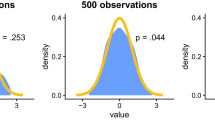Conclusion
The intelligent hypothesis testing system SVH has been implemented in an integrated CASE APS environment for software system development by structured-modular composition programming [13]. The use of CASE APS for this purpose has proved highly productive and promising, because this support system ensures software development along the life cycle spiral, i.e., it supports all technological processes from software design to operation and upgrading. These support tools are intended for applied programmers, and are sufficiently simple to learn and use. The CASE APS environment also provides support tools for efficient implementation of knowledge and data bases for the constructed applications, including SVH.
Similar content being viewed by others
References
S. A. Aivazyan, I. S. Enyukov, and L. D. Meshalkin, Applied Statistics: Principles of Modeling and Primary Data Analysis, A Handbook [in Russian], Finansy i Statistika, Moscow (1983).
Rule-Based Expert Systems: The MYSIN Experiments of the Stanford Heuristic Programming Project, Addison-Wesley, Reading, MA (1984).
R. O. Duda, P. E. Hart, and N. J. Nilsson, “Subjective Bayesian methods for rule-based inference systems,” Proc. AFIPS 1976 National Computer Conf. Vol. 45, 1075–1082 (1976).
J. Gordon and E. H. Shortliffe, “A method for managing evidential reasoning in hierarchical hypothesis space,” Artif. Intell., 26, No. 3, 323–358 (1985).
L. Zadeh, “Fuzzy sets,” Inform. Contr., No. 8, 338-353 (1965).
A. A. Afifi and S. P. Azen, Statistical Analysis: A Computer Oriented Approach, Academic Press, New York (1979).
V. N. Nosov (ed.). Computer Biometrics [in Russian], Izd. MGU, Moscow (1990).
M. L. Petrovich and M. I. Davidovich, Statistical Estimation and Hypothesis Testing by Computer [in Russian], Finansy i Statistika, Moscow (1989).
E. Lloyd, W. Lederman, S. A. Aivazyan, and Yu. N. Tyurin, A Handbook of Applied Statistics [in Russian], Vol. 2, Finansy i Statistika, Moscow (1990).
E. Lloyd, W. Lederman, S. A. Aivazyan, and Yu. N. Tyurin, A Handbook of Applied Statistics [in Russian], Vol. 1, Finansy i Statistika, Moscow (1989).
R. Forsythe, Expert Systems. Operating Principles and Examples [Russian translation], Radio i Svyaz', Moscow (1987).
M. J. Coombs and J. L. Alty, Computing Skills and the User Interface, Academic Press, New York (1981).
I. V. Sergienko, I. M. Parasyuk, O. V. Kalita, et al., “CASE APS: An integrated support system for application software development by structured-modular method,” USiM, No. 2, 30-38 (1993).
I. N. Parasyuk, A. I. Provotar, and I. A. Zalozhenkova, “The methodology of structured-modular composition programming,” Kibernetika, No. 1, 146-154 (1995).
Additional information
Translated from Kibernetika i Sistemnyi Analiz, No. 5, pp. 50–58, September–October, 1997.
Rights and permissions
About this article
Cite this article
Zalozhenkova, I.A., Parasyuk, I.N. Integrated system for hypothesis testing: Software and algorithms. Cybern Syst Anal 33, 652–658 (1997). https://doi.org/10.1007/BF02667188
Received:
Issue Date:
DOI: https://doi.org/10.1007/BF02667188




